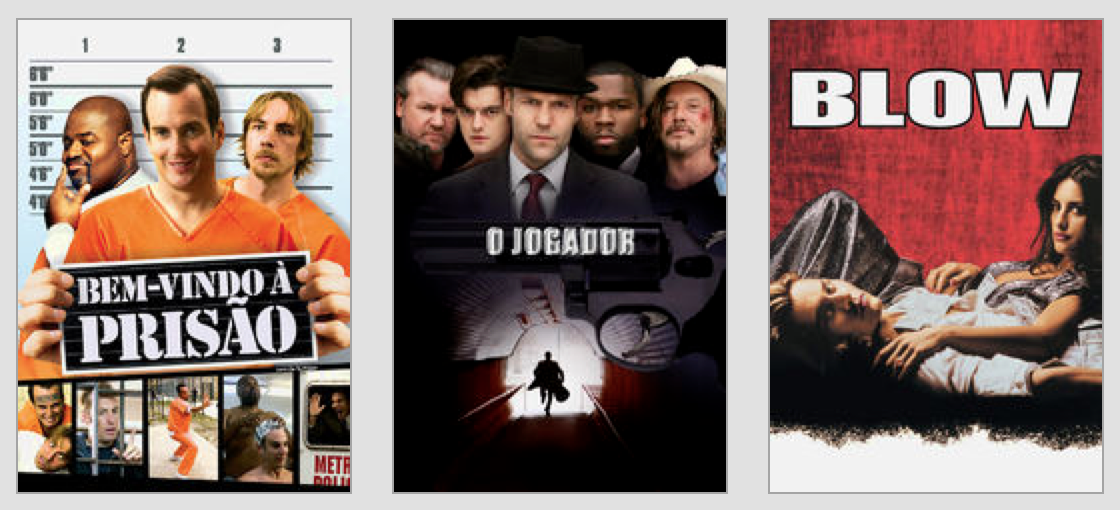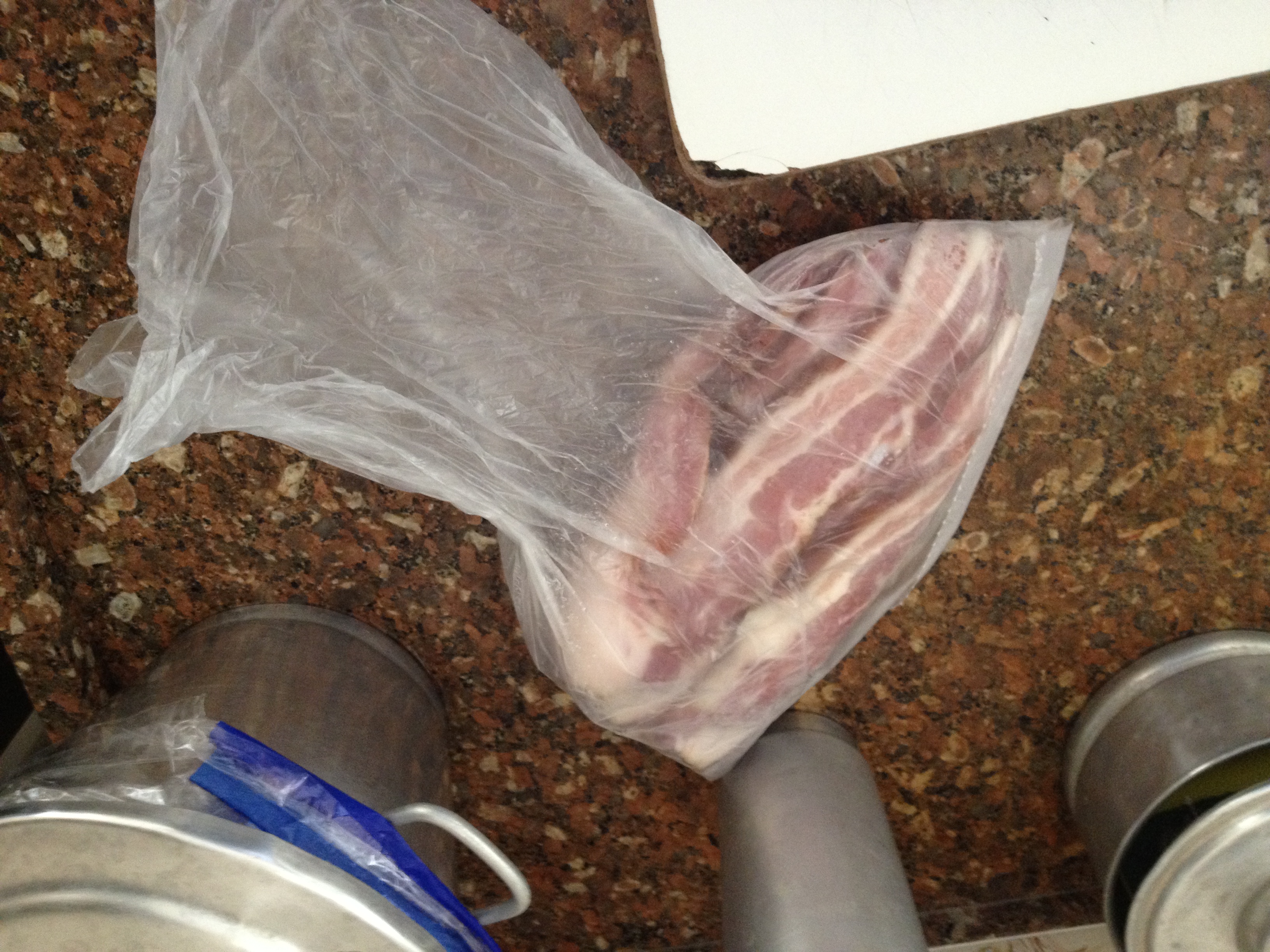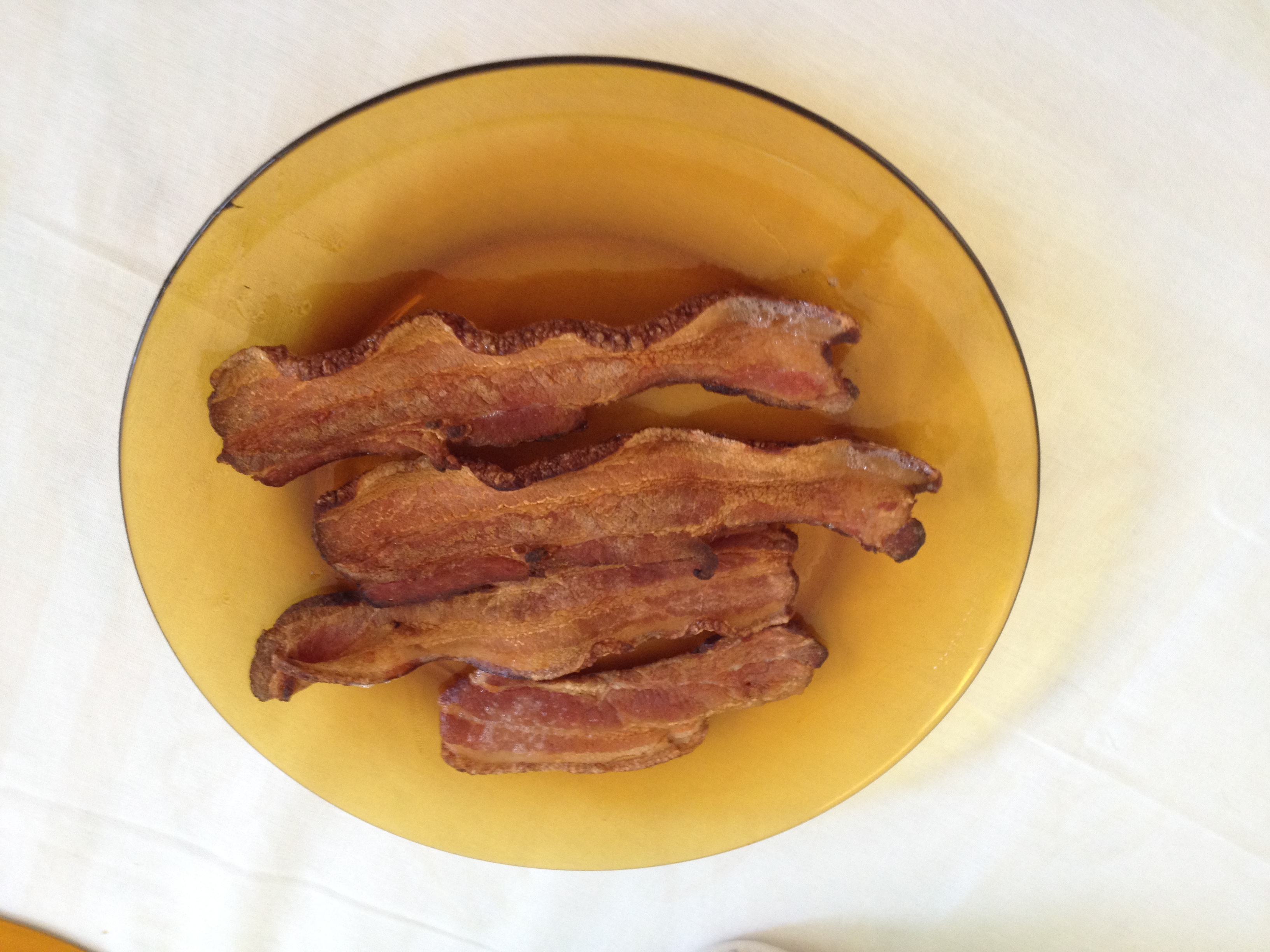How would you like your bacon?
How would you like your bacon?
I'm pretty sure if there is a heaven, this is the type of question you'd be expected to answer. As I've mentioned before, Jenifer's dad owns and runs a butcher shop, so naturally he brought forward the question, "How would you like your bacon?" I was in shock with the question, not because it was asked, but because of all the possibilities. I could get bacon any way I wanted. Let me repeat for emphasis:
Any. Way. I. Want.
I don't know what the founding father's of the US meant when they said freedom, but I think this was a part of what they were thinking in founding our great country. So what shows up the next morning? This:
No sticker, no packaging, no price, just a bag of meaty, thick cut bacon, with the skin on. I've only bought bacon in stores where they are pre-packaged, and you can only really see one of the end pieces. There's a lot of fat, and the pieces shrink up when cooked. These meaty thick cuts don't have near as much fat, so when you cook them, they only get slightly smaller. Additionally, since they are thick cut, you can't eat an entire piece in one bite. At home, even a piece of the HEB thick cut can be crammed into my garbage disposal of a mouth quite easily. The lack of fat also means that you have to add oil when pan frying, there isn't a lot of fat that will render out of the bacon. This makes for very crisp bacon. Here's a shot of the finished product:
I haven't looked for bacon in the store here, mainly because I don't have to. I will provide more bacon reports next time we go to the store. Maybe it's sold here similarly to the bacon you buy in most grocery stores, I'm not sure. All I know is bacon and coffee make for the perfect breakfast.
This place may turn me into a meat snob.
Netflix International
This was news to me, but you will see different titles when you are in different countries, even if your account wasn't created there. We've had Netflix's streaming service for a very long time, and I noticed that the trending and popular films were very different than when we left the house. I can now watch some of the greatest films of all time! Here are a few examples of things you can't stream in the US that you can stream in Brazil:
- The Shawshank Redemption
- The Godfather (all three)
- The Hobbit: An Unexpected Journey
- Training Day
Just so I don't put this in the same grouping as "greatest", these titles are also available for streaming here:
- Inglourious Basterds
- Blow
- Safe House
- Transcendence
- Ender's Game
More than 95% of movies show up under their US title, which makes things easy to find. There are some that are translated. Here are "Lets Go To Prison" and "13" under their Brazilian titles:

The only tradeoff is that a vast majority of films have no option for no subtitles, so we have to subtitle it in either Portuguese or Spanish. The only time that stinks is when there are actual subtitles in a movie where someone is speaking Chinese or something, instead of seeing it translated into English, it's into Portuguese.
Hola (VPN)
I have played with Hola a bit over the past few days. It's a free VPN service that allows you to connect to end points in almost any country in the world. This is useful for getting around geo-location restrictions on many websites. I did pay the $5/mo price for the unlimited "full pipe" VPN service. Here are the quick points of what I've noticed:
- The US L2TP service is seriously over-subscribed
- The US PPTP service seems the most stable
- Browsing is meh, streaming is sub-par.
The way I can tell the US L2TP endpoint is over subscribed is pretty strait forward. I can't authenticate a large portion of the time. When I do connect, I get some pretty serious packet loss when hitting Google and other sites. When I connect to the PPTP service, I'm able to authenticate everytime, and the packet loss goes away.
I look at Hola as an option for connectivity into the US. For most things, I setup a SOCKS proxy through a SSH tunnel to my house. The benefits to using my house:
- I control the end point, so from a tin foil hat perspective, that's good.
- I also know exactly how much bandwidth I'm using, and how much I should have available.
- In San Antonio, I have Time Warner Cable, so if a site/service has provider specific filters that block VPN providers, I can get around those
My performance through the house has been on par with Hola, largely because the DSL connection we're using here is pretty crappy.
Hola, overall, offers a tremendous amount of flexibility that I will never be able to match by proxying through my home. I can VPN in via L2TP or PPTP across a bunch of different countries, so when things like the Olympics come around, or other major events in other countries, I can connect to an endpoint in that country to bypass the geolocation filters. I would recommend trying to find a legitimate way to access what you're looking for directly before using Hola, or any other similar service for best results.
SOCKS browsing through the House
To start, you should monitor your home usage before you start proxying through it. This will help you in the event of performance issues, and you can track usage over time. This will also give you a better idea on if you need to upgrade your internet package through your ISP. I have a Cisco ASA 5505 at the edge of my network. I monitor the interfaces on this device to track how much usage is coming from my home network. Below you can see my usage from the past couple nights:

The spike you see is from me using the connection to stream the Texas Bowl where my beloved Longhorns got killed the other night. The consistent outbound traffic reflected in the blue line is from the Dropcam's running at the house.
If you're running a SSH server at home, and you have the proper firewall rules and port forwarding setup, you can easily proxy your traffic through your house. I put a link in the previous section, but here's the syntax I use to setup my client connection:
ssh -l <USER> -f -N -D 2023 <HOME IP>
The flag breakdown is simple:
-l: Login as this SSH user
-f: Put this session in the background, so it stays up even if your terminal session is closed
-N: Do not execute a remote command, just connect
-D: Local port to bind to
You can use any port over 1024 to bind to. I used to use 2022, but boot2docker binds to that port as well (took me a while to figure out why it wasn't working...), so I had to move the port I'd bind to for my SOCKS proxy. Double check all listening ports on your system before selecting your own port.
As a note, I use SSH key based authentication when connecting. This means that I'm not prompted for a password as a part of the connection, once I run the command, it connects and returns me to my lovely zsh prompt:
➜ ~ ssh -l brint -f -N -D 2023 home
➜ ~
The last step is to configure whatever you're using to use the proxy (browser, VirtualBox, ssh, whatever). Personally, I only setup one browser to use the proxy, in my case I setup Firefox to use the SOCKS proxy, and I use Chrome (my default browser) for everything else I'd like to access directly.
If you have a similar approach to mine where you always have one browser configured to use the SOCKS proxy, it means that you only need to run your ssh command to get everything up and running, once that configured browser if fired up, you're proxying through your house!
Google Drive != Dropbox for syncing
I have noticed that things I push up from my phone to Google Drive, don't always show up locally on my Macbook. I haven't really dug into the nuts and bolts of Google Drive to figure out why things don't always get synced, the FAQ was no help in this case. I've resorted to the "just restart it and see if that fixes it" approach to get around the failure of things to sync to my Macbook. Restarting Google Drive has been the cure to date. Immediately after starting it up again, the files begin syncing.

